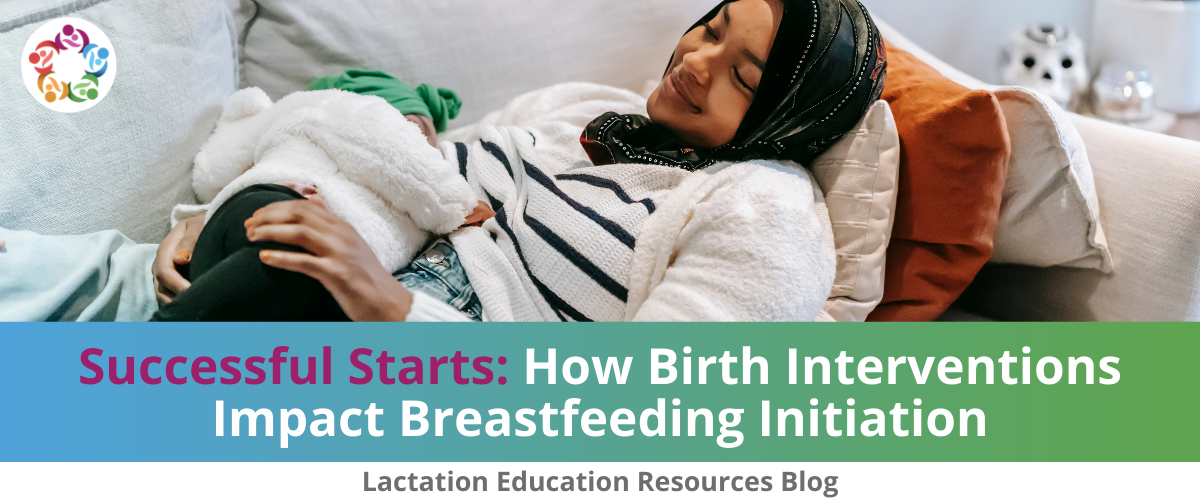Successful Starts: How Birth Interventions Impact Breastfeeding Initiation

By now, you probably know that newborns are astonishingly capable when it comes to initiating breastfeeding.
Videos of minutes-old babies making their way onto a parent’s chest, then using hands and mouth to explore, find a nipple, and latch on are some of the most moving images we see during our lactation education journeys.
But what happens to those innate behaviors, reflexes, and sequences when birth interventions are added to the picture?
The answer turns out to be, quite a lot.
Research shows that interventions during labor and delivery can significantly impair these first feeding behaviors in ways that really matter.
When early initiation is missed or doesn’t go well, that loss can have serious implications for early weight loss, parental milk supply, and even whether the pair continues to chest- or breastfeed.
In her LER conference-on-demand, Comprehensive Review of Infant Suck, world renowned researcher, writer, and practitioner Cathy Watson-Genna, BS, IBCLC, RLC, discusses the newest research on the topic of birth interventions and breastfeeding initiation.
Here are the highlights.
1. Newborn pre-feeding behaviors are hard-wired. Immediately after birth, newborns demonstrate a birth cry, relaxation, awakening, activity, crawling, resting, familiarization, sucking, and finally, recovery sleeping—although the sequence may look slightly different in different babies, with rest periods punctuating the stages.
2. The first hours are critical for lactation success. Babies are “particularly primed” to latch in the first two to three hours after birth, Watson Genna stresses. Uninterrupted skin-to-skin at this time is crucial.
3. Successful early initiation has huge impacts. When dyads are able to successfully share these initial hours and baby nurses, parents have fifty-four percent more milk on day 4. They are also more likely to still be breast- or chest-feeding at four months!
4. Birth interventions can compromise breastfeeding initiation. Several studies, some very recent, have examined the relationship between interventions in labor and lactation, with important findings in the following areas:
Exogenous Oxytocin. Several studies suggest that exogenous oxytocin is one of the interventions most likely to delay breastfeeding initiation, according to Watson Genna, and the effect is dose-dependent.
In one study (Fernandez, 2012), newborns who were exposed to the highest doses were the least likely to suck or swallow, and only those exposed to the lowest doses were exclusively breastfed at three months. Another study (Gomes et all, 2018) showed an impaired ability to latch within the first hour when babies were exposed to exogenous oxytocin, with exposed babies only half as likely to be still breastfeeding at three months. A third study (Bell et all, 2013) discovered that babies’ pre-feeding behaviors, especially hand-to-mouth movements, were less organized if they had been exposed to exogenous oxytocin in labor, while a fourth study (Gabriel et al, 2015) found a reduction in neonatal reflexes like head bobbing—reflexes that Watson Genna calls “absolutely vital to breastfeeding, especially self-attaching” in the hour or two after birth.
Opioids. “Opioids have been implicated in suppressing breastfeeding behaviors, especially in the first few hours after birth,” Watson Genna says.
Fentanyl, used by anesthesiologists to reduce the total medication needed to eliminate pain, has been particularly studied. A 2015 study (Brimdyr et al) found that the higher the dose of fentanyl given, the less likely the newborn was to suck in the first hour. In a group of babies exposed to greater than 600 micrograms over the entire labor, none latched in the first hour.
Epidurals. Does having an epidural affect breastfeeding initiation? According to a 2021 review, the answer seems to be yes, but it’s nuanced.
Essentially, it appears that greater support for chest- and breastfeeding ameliorates the effect of epidural medication on breastfeeding initiation—but it doesn’t eliminate it. The authors called for more and better research on the topic.
Earlier studies reported similar results. A 2013 study (Dozier et al) found that parents who received an epidural while giving birth in an non-Baby-Friendly hospital were more likely to stop breastfeeding before one month than those who gave birth in a Baby Friendly hospital—but those who received an epidural were still more likely to discontinue breastfeeding than those who did not. “Epidurals still had a negative impact on breastfeeding continuation in Baby Friendly hospitals, but they had less of a negative impact,” Watson Genna explains.
In general, Watson Genna stresses that it’s difficult to study the impact of any one birth intervention on breastfeeding, because birth interventions are rarely used alone.
“Epidurals and oxytocin in particular are often used together,” she notes. “So, when you’re looking at a research paper on this topic, it’s important to read the entire paper, not just the abstract—and understand the entire study—how it was constructed … and the assumptions that were made.”
Still, the available evidence builds a strong case for the impact of birth interventions on babies’ ability to begin breast- or chest feeding successfully. “The way birth is handled and breastfeeding is supported really do matter to getting off to a good start,” Watson Genna concludes.
For an in-depth look at this and 11 other topics related to the all-important subject of infant suck, register for the full course by clicking here

By now, you probably know that newborns are astonishingly capable when it comes to initiating breastfeeding.
Videos of minutes-old babies making their way onto a parent’s chest, then using hands and mouth to explore, find a nipple, and latch on are some of the most moving images we see during our lactation education journeys.
But what happens to those innate behaviors, reflexes, and sequences when birth interventions are added to the picture?
The answer turns out to be, quite a lot.
Research shows that interventions during labor and delivery can significantly impair these first feeding behaviors in ways that really matter.
When early initiation is missed or doesn’t go well, that loss can have serious implications for early weight loss, parental milk supply, and even whether the pair continues to chest- or breastfeed.
In her LER conference-on-demand, Comprehensive Review of Infant Suck, world renowned researcher, writer, and practitioner Cathy Watson-Genna, BS, IBCLC, RLC, discusses the newest research on the topic of birth interventions and breastfeeding initiation.
Here are the highlights.
1. Newborn pre-feeding behaviors are hard-wired. Immediately after birth, newborns demonstrate a birth cry, relaxation, awakening, activity, crawling, resting, familiarization, sucking, and finally, recovery sleeping—although the sequence may look slightly different in different babies, with rest periods punctuating the stages.
2. The first hours are critical for lactation success. Babies are “particularly primed” to latch in the first two to three hours after birth, Watson Genna stresses. Uninterrupted skin-to-skin at this time is crucial.
3. Successful early initiation has huge impacts. When dyads are able to successfully share these initial hours and baby nurses, parents have fifty-four percent more milk on day 4. They are also more likely to still be breast- or chest-feeding at four months!
4. Birth interventions can compromise breastfeeding initiation. Several studies, some very recent, have examined the relationship between interventions in labor and lactation, with important findings in the following areas:
Exogenous Oxytocin. Several studies suggest that exogenous oxytocin is one of the interventions most likely to delay breastfeeding initiation, according to Watson Genna, and the effect is dose-dependent.
In one study (Fernandez, 2012), newborns who were exposed to the highest doses were the least likely to suck or swallow, and only those exposed to the lowest doses were exclusively breastfed at three months. Another study (Gomes et all, 2018) showed an impaired ability to latch within the first hour when babies were exposed to exogenous oxytocin, with exposed babies only half as likely to be still breastfeeding at three months. A third study (Bell et all, 2013) discovered that babies’ pre-feeding behaviors, especially hand-to-mouth movements, were less organized if they had been exposed to exogenous oxytocin in labor, while a fourth study (Gabriel et al, 2015) found a reduction in neonatal reflexes like head bobbing—reflexes that Watson Genna calls “absolutely vital to breastfeeding, especially self-attaching” in the hour or two after birth.
Opioids. “Opioids have been implicated in suppressing breastfeeding behaviors, especially in the first few hours after birth,” Watson Genna says.
Fentanyl, used by anesthesiologists to reduce the total medication needed to eliminate pain, has been particularly studied. A 2015 study (Brimdyr et al) found that the higher the dose of fentanyl given, the less likely the newborn was to suck in the first hour. In a group of babies exposed to greater than 600 micrograms over the entire labor, none latched in the first hour.
Epidurals. Does having an epidural affect breastfeeding initiation? According to a 2021 review, the answer seems to be yes, but it’s nuanced.
Essentially, it appears that greater support for chest- and breastfeeding ameliorates the effect of epidural medication on breastfeeding initiation—but it doesn’t eliminate it. The authors called for more and better research on the topic.
Earlier studies reported similar results. A 2013 study (Dozier et al) found that parents who received an epidural while giving birth in an non-Baby-Friendly hospital were more likely to stop breastfeeding before one month than those who gave birth in a Baby Friendly hospital—but those who received an epidural were still more likely to discontinue breastfeeding than those who did not. “Epidurals still had a negative impact on breastfeeding continuation in Baby Friendly hospitals, but they had less of a negative impact,” Watson Genna explains.
In general, Watson Genna stresses that it’s difficult to study the impact of any one birth intervention on breastfeeding, because birth interventions are rarely used alone.
“Epidurals and oxytocin in particular are often used together,” she notes. “So, when you’re looking at a research paper on this topic, it’s important to read the entire paper, not just the abstract—and understand the entire study—how it was constructed … and the assumptions that were made.”
Still, the available evidence builds a strong case for the impact of birth interventions on babies’ ability to begin breast- or chest feeding successfully. “The way birth is handled and breastfeeding is supported really do matter to getting off to a good start,” Watson Genna concludes.
For an in-depth look at this and 11 other topics related to the all-important subject of infant suck, register for the full course by clicking here
By accepting you will be accessing a service provided by a third-party external to https://www.lactationtraining.com/

